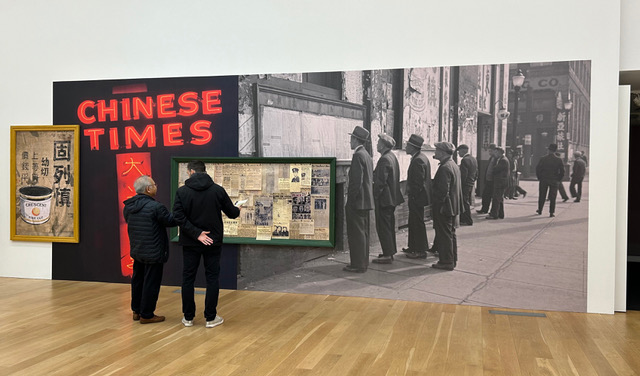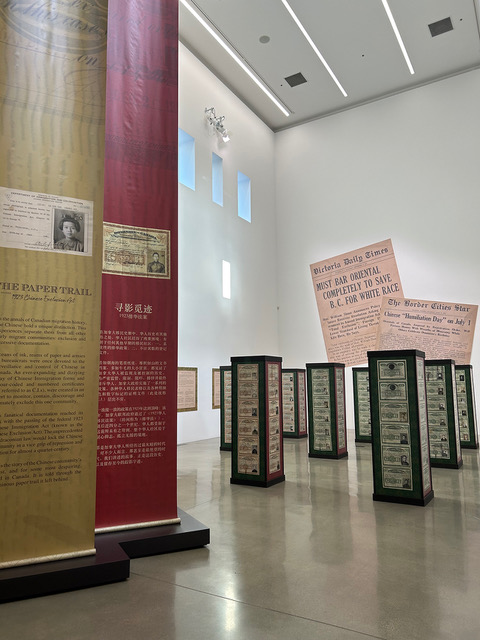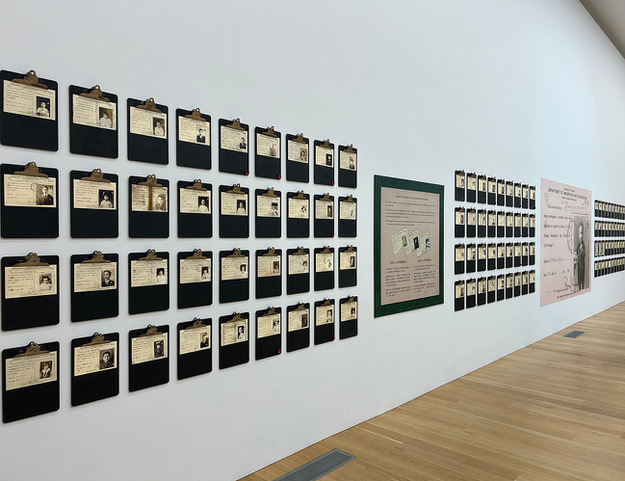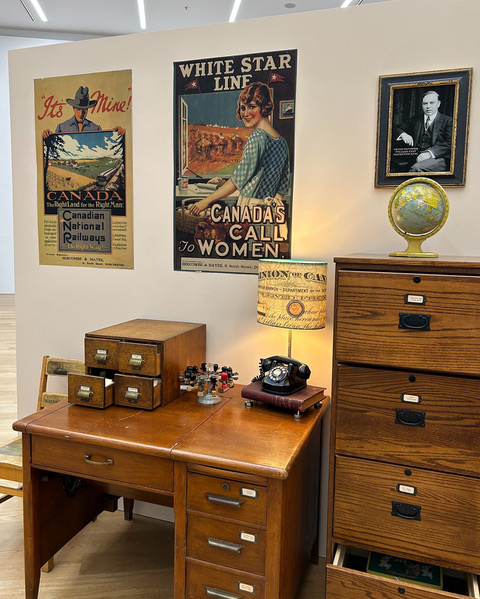
The Paper Trail to the 1923 Chinese Exclusion Act
Review By Melanie Ng
April 23, 2024
BC Studies no. 220 Winter 2023/24 | p. 109-114
1 July 2023 was not Canada Day on Pender Street. Perhaps it has not been for a long time. That year, the date instead marked the official opening of the Chinese Canadian Museum (CCM). Decades of community lobbying, advocacy, and consultation turned the dream of this museum into a reality that day, a space for telling histories that larger, national museums too often relegate to the edges of historical narratives that centre white people. Visitors to the CCM quickly learned that 1 July has hardly been a celebratory day for many Chinese Canadians, as traced in the museum’s inaugural exhibit, The Paper Trail to the 1923 Chinese Exclusion Act.
Paper Trail marks the centennial of the Chinese Immigration Act, passed on 1 July 1923. It recovers the history of loss, suffering, and separation that Chinese migrants in Canada endured under this law, commonly called the Chinese Exclusion Act due to its ban on virtually all Chinese migration to Canada. At the exhibit’s core are state-issued identity papers, or Chinese Immigration certificates (CIs). From 1885, when the Canadian federal government began charging Chinese immigrants a mandatory head tax, until 1947, when the government repealed its exclusionary immigration laws, these records served as tools in Canada’s racialized mass surveillance program. Today, they are reassembled by curator Catherine Clement and her team of researchers. A self-described “national history,” Paper Trail uses CIs to tease out tensions between the memory of Chinese migrants generated by the state and familial memories held by the descendants of those migrants who registered. It is a daunting task as the two are not always commensurable, even as they are experienced through the same piece of paper.

Three large scrolls in English, Traditional Chinese, and Simplified Chinese adorn the entrance to the exhibit, orienting visitors to the painful history before them. Their text conveys the central focus of the exhibit and informs the reader what set Chinese migrants to Canada apart “from all other early migrant communities: exclusion and excessive documentation.” The organization of the exhibit itself follows from these features. The first half introduces visitors to the legal mechanics of the state’s exclusion and surveillance networks, as well as early Chinese Canadian community responses to this exposition of documentation. The second half of the exhibit focuses on Chinese life under the terms imposed by Exclusion. Between the two is perhaps the most heart-wrenching area of the exhibit, “Bachelor’s Alley.” Here, the research team commemorates the lives of the “tens of thousands of men living alonein Canada,” forcibly separated from their families overseas, with little hope of reunion after the passage of the Exclusion Act. For these men especially, 1 July 1923 was a day of particular cruelty.

Over four hundred CIs line the walls of the exhibit, which allows visitors to see the faces of those who endured Exclusion. The arrangement of these documents represents a rebuke against the logic of mass surveillance deployed by the Canadian state. Where possible, Clement and her team have added brief biographies to the certificates on display, sharing personal intimacies and family hardships of Exclusion with the viewer. This, in essence, is a project of recovery, one that stretches all the way to the provenance of the collection itself. Clement and her team crowd-sourced the CIs in this exhibit – an assemblage of head tax certificates (CI 5s) to registration cards of Canadian-born Chinese (CI 45) – from community members. Now known as “the Paper Trail Collection,” this archive and the exhibit emerge from the desire of Chinese Canadian community members to share scans of the CIs and stories of their families. Already, other institutions have taken note. Thanks to the efforts of Clement and archivist June Chow, Library and Archives Canada has finally opened and digitized the state’s previously restricted collection of CI 44s, the certificate issued to all people of Chinese descent under the registration clause of the Exclusion Act. For a community still dealing with the generational consequences of family separation and state scrutiny caused by this law, the importance of access to their records and a say in their use can hardly be overstated.
Hints of the larger, national contexts that characterized the Exclusion Era can be found scattered around Paper Trail. In a reconstruction of a federal registration office hangs an early twentieth-century immigration poster, produced by the Canadian National Railway Company and emblazoned with the words, “It’s Mine! Canada: The Right Land for the Right Man.” The poster serves as an arresting visual distillation of the national context that produced the Exclusion Act, which a display elsewhere explains as a desire “that Canada be a ‘white’ nation.” Though subtle, the clues remind cognizant visitors that, while the amount of paperwork generated by the Exclusion Act was exceptional, the white supremacy that underwrote it was ubiquitous and directed at more people than just Chinese migrants. Canada subjected other racialized groups, including Japanese, South Asian, and Black migrants, to similar discriminatory immigration policies or race-based registration.¹ And all of this took place through the overarching violence of Indigenous dispossession. Colonialism conditioned Exclusion.

Given the forces that defined the nation, it is perhaps for the better that Paper Trail exceeds its own label of national history. Nowhere is this better seen than in the two documentaries that accompany the exhibit. In the first, Memories of Chinese Bachelors,Clement explains that these men “are the ones we’ve most forgotten about” in our national memory. Yet, as multiple interviewees attest in the course of the film, these men have not been forgotten by the people they cared for. Many bachelors adopted “uncle” roles to Chinatown’s children during the time that the Exclusion Act kept them away from their own kin. These experiences of separation and delayed reunification are evocatively captured in the exhibit’s second film documentary, Stories of Repeal and Reunion. In this documentary, overseas men are not forgotten but remembered, their presence longed for and missed by family back home. Despite Exclusion’s repeal, anti-Chinese immigration policies that persisted beyond it continued to separate generations of families. Fathers felt more like strangers to their children, who knew them solely through photographs, until they could meet – sometimes for the first time – in adulthood. Together, these documentaries highlight the gulf between national memory and family memories, the latter contained in transnational ties of kinship and belonging.

It is a testament to the work of Clement and her team that the end of Paper Trail is, in fact, a beginning. For so many community members and visitors, the documents are the start of a conversation about aspects of Chinese migration hidden by national memory. Museum guides have remarked that as descendants of the CI bearers visit this gallery they often impart personal stories about their ancestors.² The guides are then able to share these stories with future visitors. The CIs that anchor Paper Trail undoubtedly provided a powerful visual of Exclusion. But telling stories about Exclusion need not be defined by state documents. Those documented did not need to be documented to exist. Even when spread out across the Pacific, their relations who remember them are evidence enough.
ACKNOWLEDGEMENTS
I am particularly grateful for the kindness and generosity of Elwin Xie, an invaluable guide to the Chinese Canadian Museum. Elwin Xie shared his wisdom and family stories and was exceedingly patient in answering my many questions about Vancouver’s Chinese communities.
- These policies included: the Continuous Journey Regulation (1908), the Gentleman’s Agreement (1908), and Order in Council, PC 1911-1324 (1911).
- The BC Studies Summer 2023 issue contains two such personal memories as told by Imogene Lim and Naomi Louie. Their ref lections expand on the stories behind the CIs of their own ancestors and serve as examples of the hundreds of broader remembrances and family histories that exceed the paper trail of state CIs.
Publication Information
The Paper Trail to the 1923 Chinese Exclusion Act. Curated by Catherine Clement. Vancouver: Chinese Canadian Museum, 2023.
